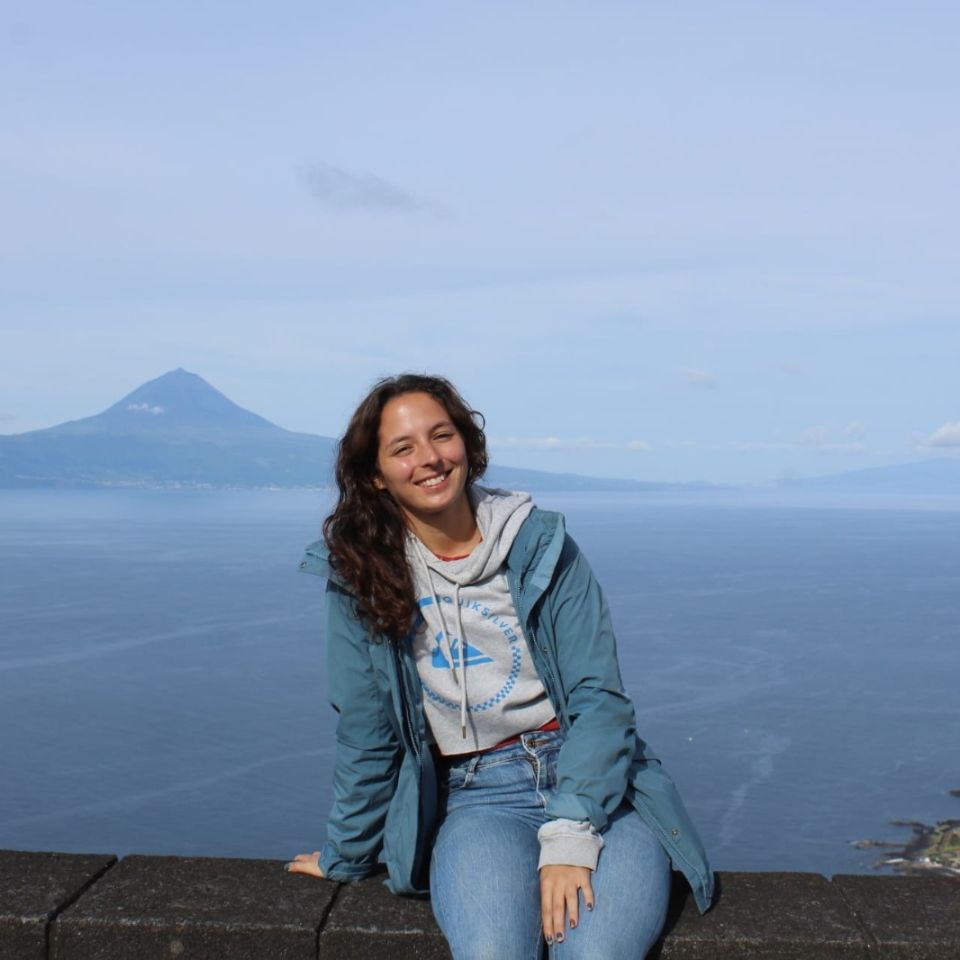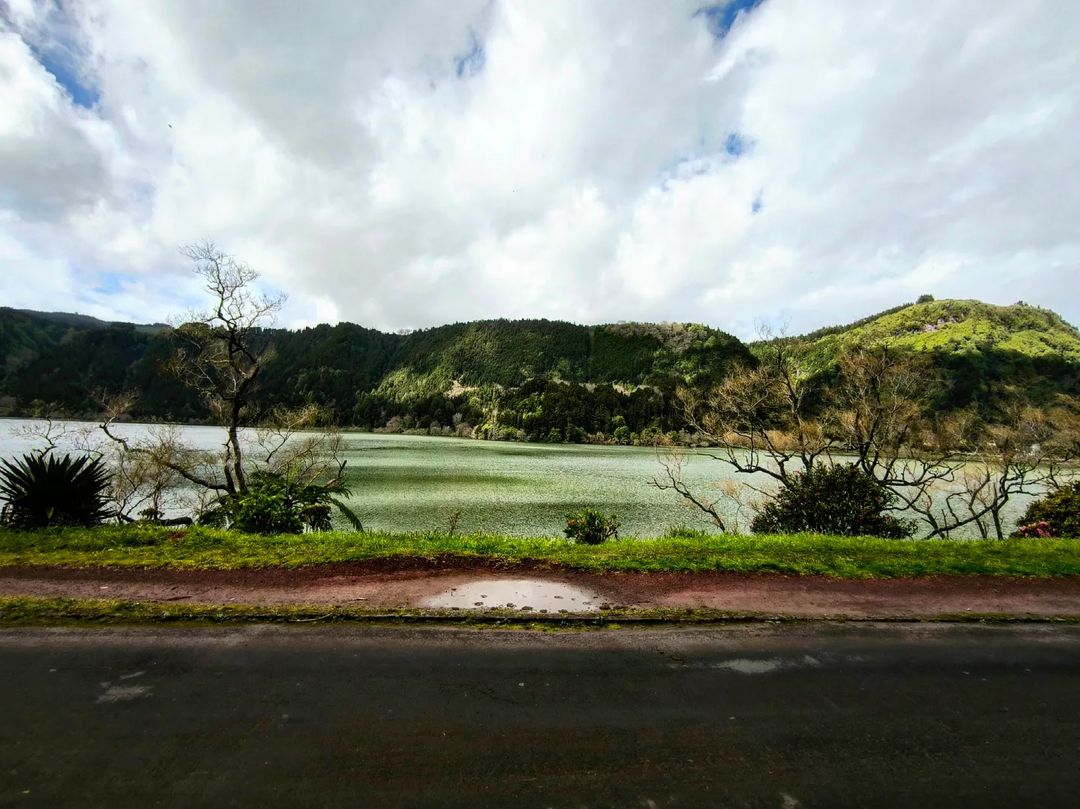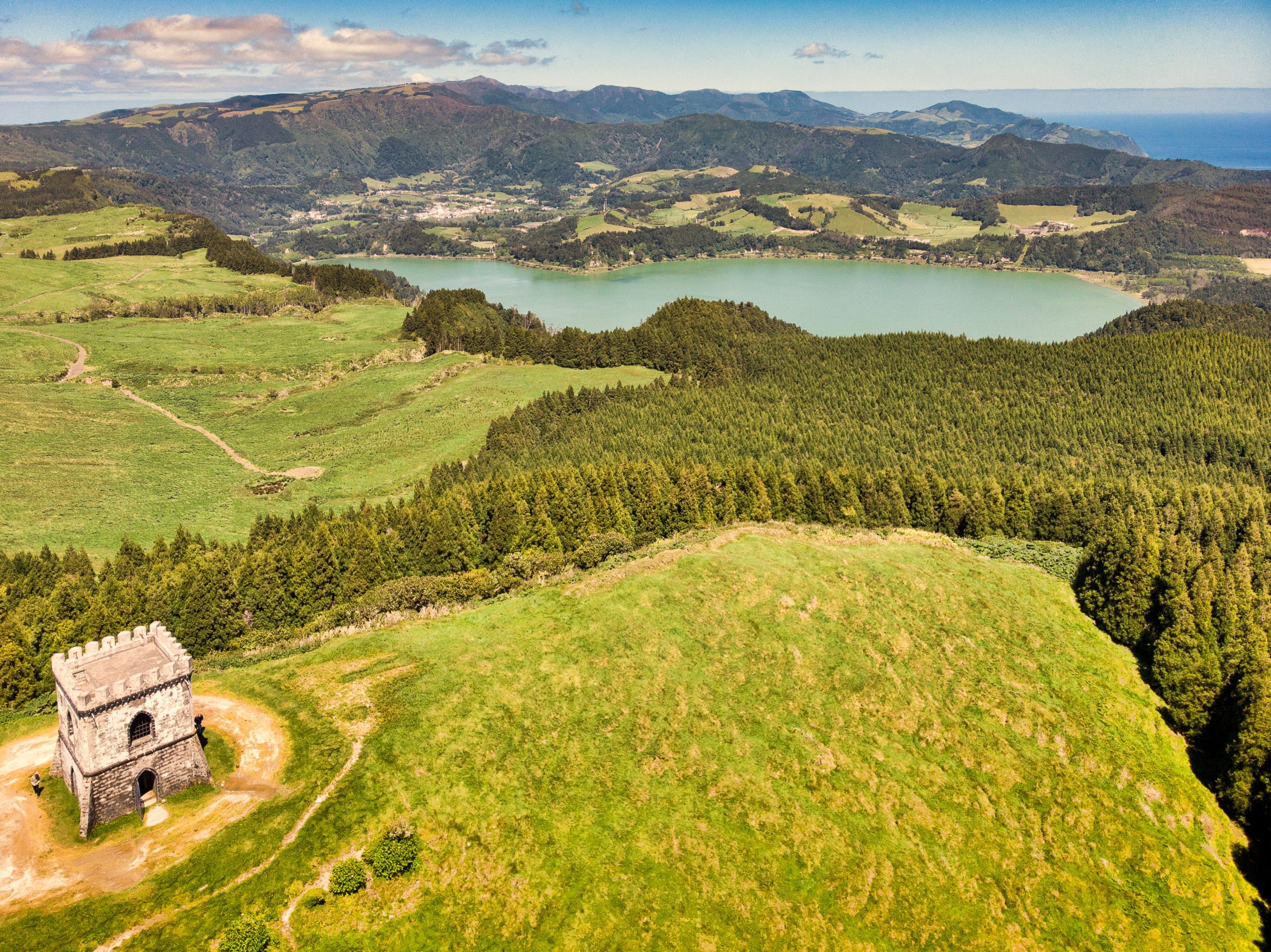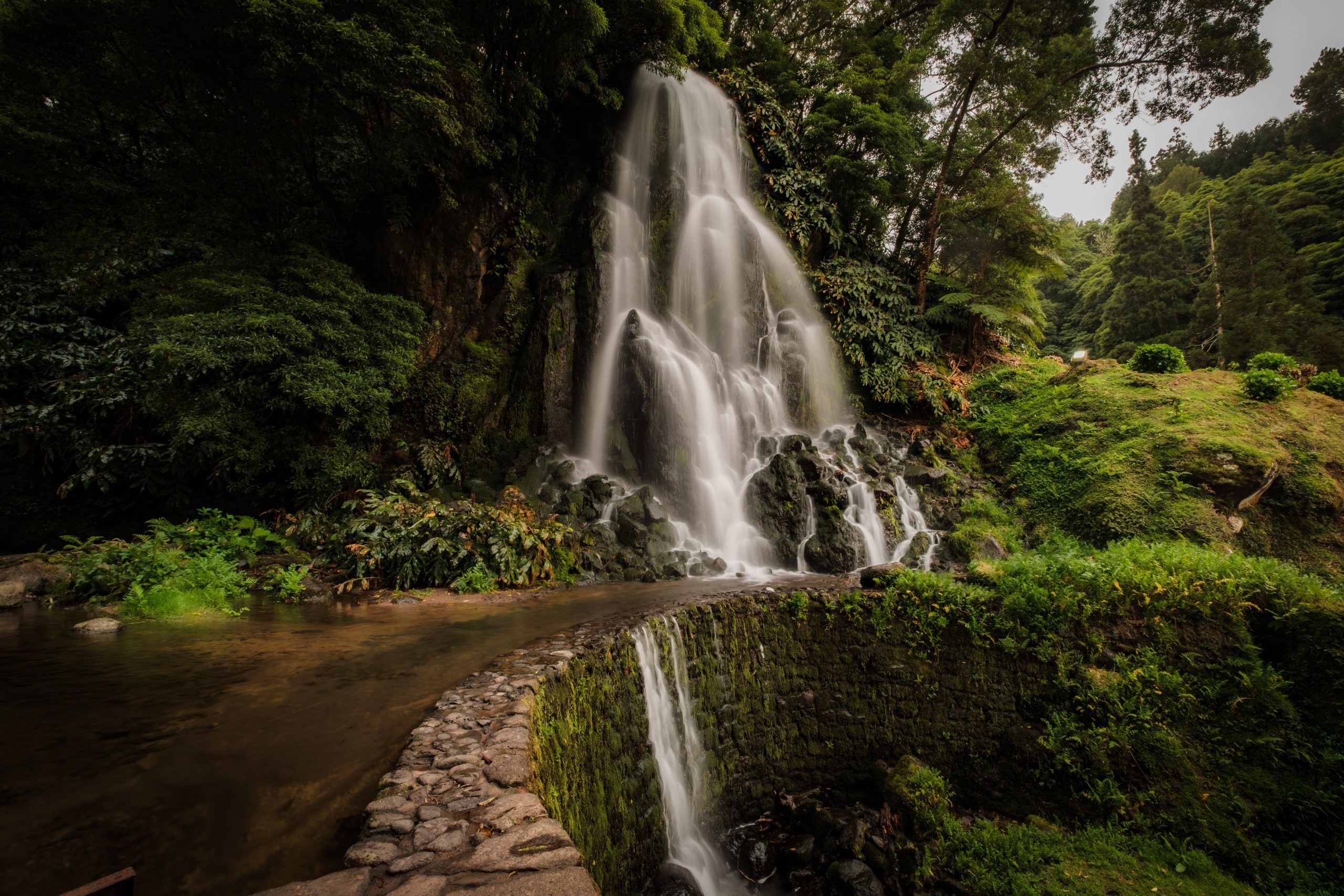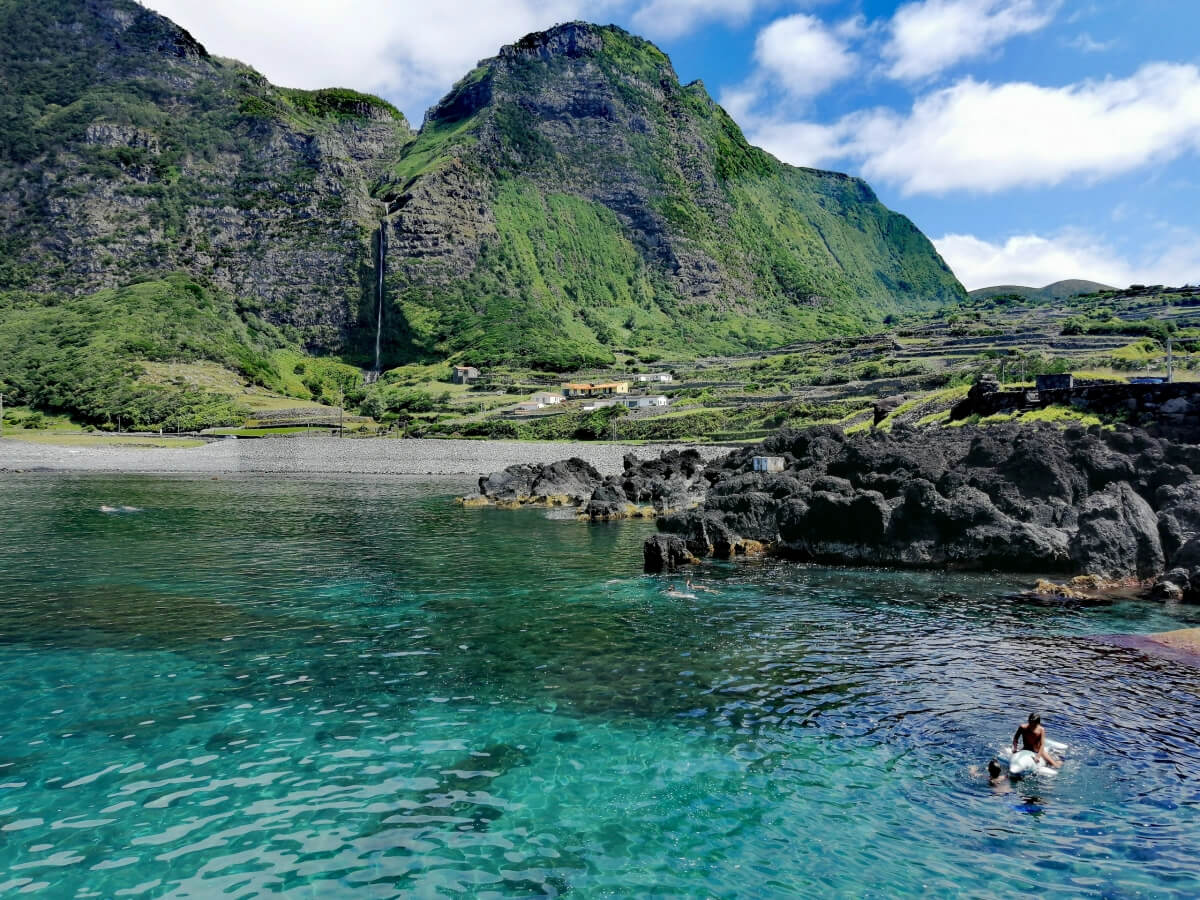It is truly amazing what nature can do by itself, and Rocha dos Bordões is a perfect example of that magic. This is a massive basalt wall composed of several pipes, resembling a natural organ or various rock staffs that have been put together.
Rocha dos Bordões (literally the Rock of Staffs) is undoubtedly a wonder of nature. This geological formation is part of the Morro Alto Special Area of Conservation (SAC). It is registered in the Natura 2000 network and is also a geosite of the Azores, designated as such by UNESCO.
Let’s discover more about this breathtaking place on the small Flores Island in the Azores archipelago.
What is Rocha dos Bordões

Rocha dos Bordões is a geological structure composed of trachybasaltic lava flows that cooled, creating a picturesque rocky wall with distinct character. It was formed by an eruption that occurred more than 570,000 years ago and remains well-preserved to this day. The columns are about 20 meters high, and the rock in itself represents 10 hectares, at an altitude of around 493 meters above sea level.
Along with the famous blue hydrangeas all around this spot, you can find plenty of vegetation. On the endemic side, observe the Azores juniper, Frangula azorica, Picconia azorica, Erica azorica, and Azores blueberry. In terms of birds, you will probably be able to see the Azores chaffinch, the Eurasian blackcap, the Grey wagtail, the Common blackbird, and the Goldcrest.
Plan Your Visit to Rocha dos Bordões

How to Get to Rocha dos Bordões
Rocha dos Bordões is located on the main road ER1-2, between the towns of Mosteiro and Lajedo. It belongs to the Lajes das Flores county.
You can grab your rental car and drive on that road. When you pass by either Mosteiro or Lajedo, you will then find a sign at some point, right on the side of the road, indicating the viewpoint “Miradouro da Rocha dos Bordões”. There, you can park your car safely and enjoy the view.
Planning a trip to the Azores? These articles will help you: How to Get to the Azores 🗺️ | Azores airports 🛬 | Flights between islands ✈️ | Ferries between islands ⛴️ | Which island to choose? 🏝️ | What airlines fly to the Azores? 🛩️
Best Time to Visit
Depending on the time of day and the weather conditions, the rock will appear completely different. If there is a low cloud cover on the South-West part of the island, chances are you will not be able to see Rocha dos Bordões. It is better to go with bright sun or high clouds.
Check all our articles about the weather in the Azores throughout the year 🌤️ ☔️: January | February | March | April | May | June | July | August | September | October | November | December
Pro Tips
This is an excellent spot for photography enthusiasts. The dark rock contrasting with the bright green of the vegetation around, and the deep blue of the Atlantic Ocean in the back, is all you can ask for to take a typical Azorean photo. Come at different times to truly enjoy this place with the other lights of the day.
What to Do Around Rocha dos Bordões
Explore the Municipality of Lajes das Flores

Located in the town of Lajes das Flores, this city is situated on the south coast of Flores Island and is part of the Western Group of the Azorean archipelago. The municipality of Lajes das Flores is the westernmost in Europe.
Founded in 1515, this municipality is divided into seven parishes: Fajã Grande, Fajãzinha, Fazenda, Lajedo, Lajes das Flores, Lomba, and Mosteiros. Here, the locals seem to live in perfect balance with nature. Surrounded by breathtaking landscapes in every nook and cranny, there is an extensive natural and built heritage that deserves to be visited.
With this in mind, we’ve decided to highlight some of the main tourist attractions in this region:
- Lajes das Flores Pier Battery;
- Church of Nossa Senhora do Rosário;
- Fort of St. Anthony of Lajes das Flores;
- Lajes das Flores harbor;
- Sete Lagoas — Lagoa Branca, Lagoa Comprida, Lagoa Funda, Lagoa Funda das Lajes, Lagoa Rasa and Lagoa Seca;
- Lagoa da Lomba;
- Rocha dos Bordões;
- Rocha dos Frades;
- Fajã de Lopo Vaz;
- Craveiro Lopes Viewpoint;
- Lajedo Viewpoint;
- Fajã do Conde viewpoint;
- Ponta Negra Lookout Viewpoint
- Gruta do Galo;
- Enxaréus Cave;
- Monchique Islet;
- Alagoa Bay;
- Among many others.
Explore the Seven Lakes of Flores

The seven lakes (Sete Lagoas) are all located inside the caldera of a volcano on Flores Island.
There is Lagoa Negra (the black lake), Lagoa Branca (the white lake), Lagoa Comprida (the long lake), Lagoa Rasa (the shallow lake), Lagoa Funda (the deep lake), Lagoa Seca (the dry lake) and Lagoa da Lomba (lake of the hill). Their names are pretty descriptive and representative of each lake, owing to their distinctive colors, depths, and locations.
They are all worth a visit and unique in their way, creating beautiful scenery for your island pictures.
Let Cascata da Ribeira do Ferreiro Take Your Breath Away

Poço da Ribeira do Ferreiro, also known as Poço da Alagoinha or Lagoa das Patas, is without a doubt the number 1 attraction on Flores Island. It is the green wall of vegetation, full of thin and tall waterfalls flowing through it, which you often see on the internet when searching for the Azores islands, or more specifically, Flores.
This magical place speaks for itself and will leave you speechless. This is one of the reasons why travelers consider taking the extra plane trip to Flores Island.
Take a Dip at Poço do Bacalhau
The Poço do Bacalhau Waterfall is an imposing waterfall that falls approximately 90 meters to form a small lake called Poço do Bacalhau. As you might expect, this place is popular with kids and adults alike, who come here to enjoy themselves.
This magnificent natural tourist attraction, often used as a bathing area, is surrounded by a magical atmosphere where the Azorean endemic vegetation is predominant — the well-known Macaronesian Laurissilva and the extensive area of moss (sphagnum sp.).

Did you know
The Poço do Bacalhau Waterfall has been part of the UNESCO World Network of Biosphere Reserves since 2009.
It’s important to note that despite being a popular spot for tourists, the Poço do Bacalhau waterfall is remarkably well-preserved in terms of fauna and flora. Additionally, there are tourist facilities, including car parks and restaurants, near the waterfall.
What are you waiting for to dive into this magical pool? Savor these clear, refreshing waters!
Check all our articles about each one of the most relevant points of interest on Flores Island: Poço do Bacalhau | Rocha dos Bordões
Complementary Information
Best Season to Visit the Azores
The Azores Archipelago boasts a unique climate that shapes its lush landscapes, making it a splendid year-round destination. With mild temperatures and minimal fluctuations, each season offers something unique. Spring averages 16 °C, summer reaches 21 °C, autumn cools to 18 °C, and winter remains mild at 14 °C.
→ For a detailed breakdown of the weather by month, check the following links 🌤️☔️: January | February | March | April | May | June | July | August | September | October | November | December
How to Get to the Azores
The Azorean Archipelago is easily accessible through numerous flight routes. Lisbon and Porto are the main entry points to the continent, with direct flights available to São Miguel (PDL), Terceira (TER), Faial (HOR), Pico (PIX), and Santa Maria (SMA). To find the best flight, use search engines like eDreams or Skyscanner. These platforms enable you to compare prices and schedules from various airlines in one convenient location.
For more details on how to get to the Azores, take a look at our complete guide. But what if you want to explore beyond your arrival island? We’ve got you covered!
- Azores airports 🛬
- Flights between islands ✈️
- Ferries between islands ⛴️
- Which island to choose? 🏝️
- What airlines fly to the Azores? 🛩️
→ Once you’ve found the perfect route, book your tickets and get ready to experience one of the world’s most stunning island groups!
Travel Essentials
Essential Information for your Azores trip: Azorean Language & Phrases 🗣️ | Currency & Banks 💵 | Credit Cards & Traveler’s Cheques 🏧 | Driving in the Azores 🚗 | Electricity 🔌 | Experiences & Tours 🗺️ | Health & Safety 🩺 | Internet & Wi-Fi Access 🛜 | Phones & Mobile Service 📞 | Post Offices & Buying Stamps ✉️ | Public Holidays 🏖️ | Shopping 🛒 | Time & Daylight 🕒 | Whale Watching Guide 🐳 | Best Island to Visit 🏞️
Useful Tools & Apps
The weather in the Azores can be variable, so it’s helpful to use some apps before visiting the islands. Spotazores provides live camera feeds from the main tourist attractions, allowing you to check the weather and plan your visit. For accurate weather predictions, use Windy or Windguru — they provide the most reliable predictions.
Video
Conclusion
If you are on Flores Island for your holidays in the Azores, then you definitely need to take a look at Rocha dos Bordões. Plus, no detour is necessary as it is visible from the main road when you are driving in the southwest part.
This geological treasure is unmissable. Even if people don’t know this place, they stop at the viewpoint to take in the stunning view. It looks like a natural miracle. Enjoy Rocha dos Bordões to take plenty of pictures, as this is certainly something you don’t see every day.
Authors’ Note
I am pleased to inform you that all the recommendations in this article are based on my personal experience and observations. As the author, I have personally visited each attraction mentioned, ensuring that every suggestion is grounded in first-hand knowledge and genuine enthusiasm.
FAQs
Rocha dos Bordões is a geological formation on Flores Island, Azores, consisting of impressive vertical basalt columns that resemble giant organ pipes. It’s one of the island’s most iconic natural landmarks.
The slow cooling of lava formed this unique rock formation, creating prismatic basalt columns. Erosion over time exposed these towering structures, giving them their current appearance.
Rocha dos Bordões is located near the parish of Mosteiro, in the municipality of Lajes das Flores, on the southwest side of Flores Island. It’s accessible by road and includes a designated viewpoint.
You can visit the formation year-round, but the golden light at sunset especially enhances the texture and color of the basalt columns, making the experience magical. Clear days also offer sweeping views over the surrounding landscape.


